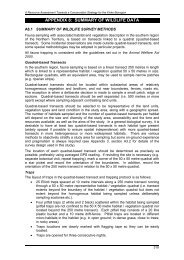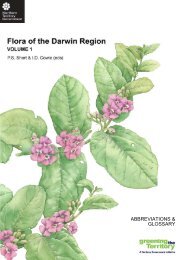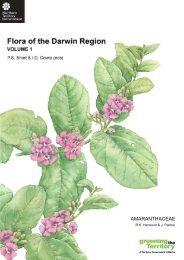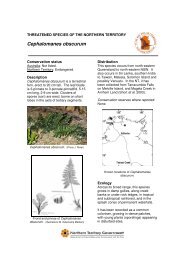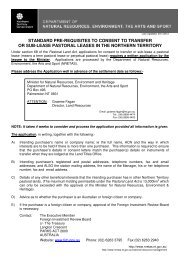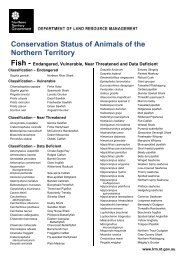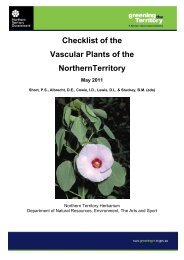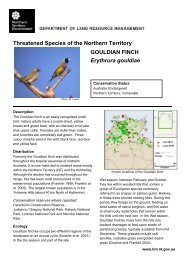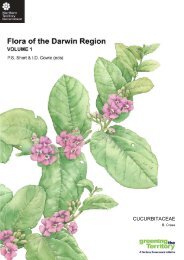Neurada Neurada procumbens
Neurada Neurada procumbens
Neurada Neurada procumbens
Create successful ePaper yourself
Turn your PDF publications into a flip-book with our unique Google optimized e-Paper software.
Despite efforts to restrict spread from its original known location, it has now been found in other areas<br />
throughout Central Australia.<br />
In the Northern Territory neurada is starting to spread at a number of campgrounds in the region. Camels,<br />
cattle and rabbits occur in the vicinity of the primary infestation and their tracks have been observed amongst<br />
plants. These animals are likely to disperse the fruit some distance from existing population and camels<br />
particularly are likely to be the main vectors for the spread of the species into areas distant from vehicle<br />
tracks.<br />
Preventing spread of neurada<br />
Spread prevention is always the most successful and cost effective way of managing weeds. <strong>Neurada</strong><br />
seeds are readily spread by domestic stock, water flow (rain, floods), feral animals and by human means.<br />
As neurada has been found in a number of areas frequented by tourists, it has become evident that all<br />
visitors should be aware of how to identify neurada and avoid inadvertent spread. Anyone travelling though<br />
areas affected by neurada should check vehicles, clothes, shoes and camping gear to ensure they are<br />
not carrying neurada’s spiky fruit. These infestations are current management priorities as further spread<br />
and establishment into clean areas is a significant risk. Given the extremely limited extent of neurada<br />
infestations, it is very important that any new plants are immediately controlled following detection. Even<br />
plants which have been controlled should be reported so that necessary follow up can occur.<br />
<strong>Neurada</strong> control<br />
Prevention and early intervention are the most cost-effective methods of control. The success and type of<br />
control measure used will depend on the situation, although foliar spraying with herbicide or hand pulling are<br />
generally the preferred forms of control for the low density infestations found in the Northern Territory.<br />
Seed germination generally occurs following significant rainfall events. This is therefore the best time to look<br />
out for and control neurada.<br />
Physical removal of <strong>Neurada</strong> is quite easy as the plant is small and easy to access due to its current low<br />
infestation levels. As the Northern Territory only has low density neuarada infestations, hand pulling is the<br />
most appropriate form of physical control.<br />
If tourists find the spiky seeds on their clothing or car tyres etc, the best way to destroy these seeds is to<br />
collect them and burn them in a campfire.<br />
Chemical control<br />
Chemical and<br />
concentration<br />
2, 4-D amine 625g/L<br />
Various trade names<br />
Glyphosate 360 g/L<br />
Various trade names and<br />
formulations<br />
Rate Situation, method and comments<br />
320 ml / 100L Seedling or adult (individuals or infestation)<br />
Foliar spray - apply when actively growing<br />
10 ml / 1L Seedling or adult (individuals or infestation)<br />
Foliar spray - apply when actively growing<br />
Optimum treatment time – 4-6 weeks after rainfall in the region<br />
Follow up<br />
It is vital that follow up works are carried out to control seedling recruitment and regrowth after a site has been<br />
treated. It is unknown how long <strong>Neurada</strong> seeds can remain viable in soil, so monitoring will need to continue<br />
for at least 10 years in areas where neurada is known to have seeded. As seeds germinate after significant<br />
rainfall events, this is the optimum to do follow up and monitoring activities.<br />
www.greeningnt.nt.gov.au



